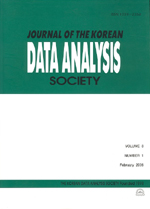표본추출이론에서 설계기반 추론과 모형기반 추론의 비교
A Comparison of Design-based and Model-based Inference in Survey Sampling
- 한국자료분석학회
- Journal of The Korean Data Analysis Society (JKDAS)
- Vol.10 No.4
-
2008.082149 - 2160 (12 pages)
- 12

오늘날 표본조사에서 설계기반 접근 방법이 주류를 이루고 있지만 모형기반 접근 방법 또한 상당한 의미를 차지하고 있는 것이 사실이다. 이 들 두 방법은 서로 장·단점을 지니고 있으며, 따라서 둘 다 허용가능하다고 볼 수 있다. 1970년 Royall에 의해 표본 추출 방법의 한 대안으로서 다시 주목받기 시작한 모형기반 추론의 기반이 되는 균형 추출방법(purposive selection 또는 balanced sampling)과 설계기반 추론의 기반이 되는 확률 추출방법(randomized sampling)의 장·단점을 층화 추출법에서 비추정량을 사용하는 경우를 예로 들어 비교하였다. 본 논문에서는 균형 추출방법은 강건성(robustness)과 효율성(efficiency) 측면에서 확률 추출방법은 추출의 간편성과 사회적 인식 측면에서 각각의 장점을 지니고 있다 것을 예감분산과 경험적 예를 통하여 나타내었다.
While the design based approach has been widely used in sample surveys the model based approach as an alternative method to improve and better estimate or predict population parameter of interest also has an very important meaning. Since those two methods have merits and demerits we can say that both of them are admissible. The purposive selection or balance sampling was suggested by Royall(1970) as an alternative method of sample selection. We compared the two sampling, the balanced sampling and the randomized one, in view of the stratified random sampling and ratio estimator. We can show that balanced sampling has merits in robustness and efficiency while randomized sampling has merits in the simpleness of selection and social recognition.
1. 서론
2. 설계기반 추론
3. 모형 보조 추론
4. 모형 기반 추론
5. 설계 및 모형기반 추론의 비교
6. 결론
참고문헌
(0)
(0)